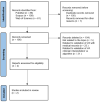Verbal Autopsy as a Tool for Defining Causes of Death in Specific Healthcare Contexts: Study of Applicability through a Traditional Literature Review
- PMID: 36142022
- PMCID: PMC9517079
- DOI: 10.3390/ijerph191811749
Verbal Autopsy as a Tool for Defining Causes of Death in Specific Healthcare Contexts: Study of Applicability through a Traditional Literature Review
Abstract
Autopsy examination, the gold standard for defining causes of death, is often difficult to apply in certain health care settings, especially in developing countries. The COVID-19 pandemic and its associated difficulties in terms of implementing autopsy examinations have made the need for alternative means of determining causes of death even more evident. One of the most interesting alternatives to the conventional autopsy is the verbal autopsy, a tool that originated in Africa and Asia in the 1950s and consists of a structured interview with the deceased's family members concerning the symptoms manifested by the person and the circumstances of death. In the early 1990s, the first doubts emerged about the validity of verbal autopsies, especially about the real reliability of the cause of death identified through this tool. The objective of the review was to identify studies that had assayed the validity of verbal autopsies through a rigorous comparison of the results that emerged from it with the results of conventional autopsies. When starting from an initial pool of 256 articles, only 2 articles were selected for final review. These are the only two original research articles in which a verbal autopsy validation process was performed by employing the full diagnostic autopsy as the gold standard. The two papers reached opposite conclusions, one suggesting adequate validity of verbal autopsy in defining the cause of death and the other casting serious doubts on the real applicability of this tool. Verbal autopsy undoubtedly has extraordinary potential, especially in the area of health and demographic surveillance, even considering the implementation that could result from the use of artificial intelligence and deep learning. However, at present, there appears to be a lack of solid data to support the robust reliability of this tool in defining causes of death.
Keywords: cause of death; complementary methodology; morbid condition; pandemic; verbal autopsy.
Conflict of interest statement
The authors declare no conflict of interest.
Similar articles
-
The validity of verbal autopsies for assessing the causes of institutional maternal death.Stud Fam Plann. 1998 Dec;29(4):414-22. Stud Fam Plann. 1998. PMID: 9919634
-
Verbal autopsies for adult deaths: issues in their development and validation.Int J Epidemiol. 1994 Apr;23(2):213-22. doi: 10.1093/ije/23.2.213. Int J Epidemiol. 1994. PMID: 8082945 Review.
-
Ascertaining cause of mortality among middle-aged and older persons using computer-coded and expert review verbal autopsies in the China Health and Retirement Longitudinal Study.Glob Health Action. 2020 Dec 31;13(1):1768502. doi: 10.1080/16549716.2020.1768502. Glob Health Action. 2020. PMID: 32544003 Free PMC article.
-
Validity of verbal autopsy method to determine causes of death among adults in the urban setting of Ethiopia.BMC Med Res Methodol. 2012 Aug 28;12:130. doi: 10.1186/1471-2288-12-130. BMC Med Res Methodol. 2012. PMID: 22928712 Free PMC article.
-
Verbal autopsies and SUDEP.Epilepsy Behav. 2009 Apr;14(4):573-6. doi: 10.1016/j.yebeh.2009.02.001. Epub 2009 Feb 10. Epilepsy Behav. 2009. PMID: 19435572 Review.
Cited by
-
Validating the diagnostic accuracy of medical certification: a population-level comparison between verbal autopsy and Saudi medical records causes of death of deceased with type 2 diabetes.Glob Health Action. 2024 Dec 31;17(1):2448382. doi: 10.1080/16549716.2024.2448382. Epub 2025 Jan 20. Glob Health Action. 2024. PMID: 39829380 Free PMC article.
-
Rethinking 'Probable Cause of Death': A comparative analysis of Physician-Certified Verbal Autopsy and Forensic Autopsy Outputs in community deaths in Lusaka, Zambia.Forensic Sci Int Synerg. 2025 Jun 12;11:100614. doi: 10.1016/j.fsisyn.2025.100614. eCollection 2025 Dec. Forensic Sci Int Synerg. 2025. PMID: 40574871 Free PMC article. No abstract available.
-
A scoping review on the errors in medical certification of the cause of death in India.Indian J Med Res. 2024 Jul;160(1):11-21. doi: 10.25259/IJMR_498_23. Indian J Med Res. 2024. PMID: 39382496 Free PMC article.
-
Accuracy of the Verbal Autopsy questionnaire in the diagnosis of COVID-19 deaths in a Brazilian capital.Rev Inst Med Trop Sao Paulo. 2024 May 13;66:e33. doi: 10.1590/S1678-9946202466033. eCollection 2024. Rev Inst Med Trop Sao Paulo. 2024. PMID: 38747854 Free PMC article.
-
Using Natural Language Processing to Predict Fatal Drug Overdose From Autopsy Narrative Text: Algorithm Development and Validation Study.JMIR Public Health Surveill. 2023 May 19;9:e45246. doi: 10.2196/45246. JMIR Public Health Surveill. 2023. PMID: 37204824 Free PMC article.
References
-
- Waters B.L. Handbook of Autopsy Practice. 4th ed. Springer-Verlag; New York, NY, USA: 2009. pp. 3–7.
-
- Madea B., Argo A. Handbook of Forensic Medicine. John Wiley & Sons; Hoboken, NJ, USA: 2014. Certification of death: External postmortem examination; pp. 57–74.
Publication types
MeSH terms
LinkOut - more resources
Full Text Sources
Medical


